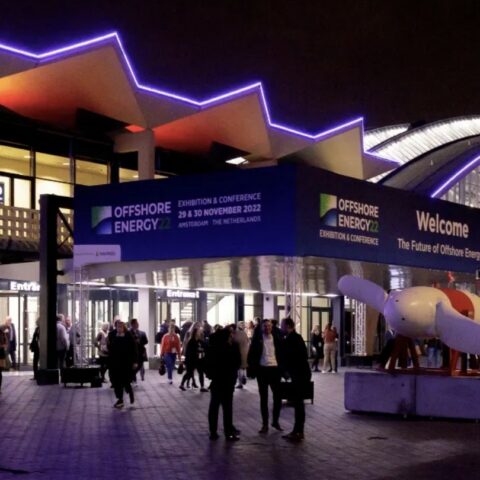Home Fossil Energy Discriminating against hydrogen colors will not get us any further
Hydrogen, deemed as a connector for offshore energy markets, is yet to play a very important role, especially in hard-to-abate sectors. The energy transition and especially the hydrogen transition can be built efficiently, faster, cheaper, and with fewer emissions if we build it on existing knowledge from existing assets, panelists concluded at the Offshore Energy Exhibition & Conference.
 Navingo BV
Navingo BV
The Hydrogen: The great connector session at OEEC 2023 held in Amsterdam gathered Eric Vennix, Partner Consulting at Deloitte Netherlands, Miriam Bardolet Pou, Director Energy Transition Fund at Copenhagen Infrastructure Partners (CIP), Lex de Groot, Managing Director at Neptune Energy Netherlands, Martin Kjäll-Ohlsson, Executive Vice President of Vergia, and moderator Paul de Leeuw, Director Energy Transition Institute at Robert Gordon University.
The panelists agreed that hydrogen will play a very important role, especially in hard-to-abate sectors, and that it is a given that hydrogen is a connector to other markets. However, the questions of hydrogen economy and business model are yet to be answered.
According to Eric Vennix from Deloitte, it is expected that a lot of new offshore assets will be required to support the growth of hydrogen production, such as new electricity and energy hubs, transmission innovations, and also vessels and equipment to realize the planned assets.
However, Vennix notes that action is still needed to enable the development of the hydrogen economy because there is none at present at the scale that is required and financing needs to become available that lowers the cost of capital for hydrogen projects.
“Whatever scenario you look at, be it those from Shell or the International Energy Agency or the Hydrogen Council, it is all clear that [hydrogen] will grow. The only thing which is a bit more uncertain is the pace at which that will take place. Despite this uncertainty, all three scenarios show that global clean hydrogen production and consumption in 2050 will exceed the current gray hydrogen production and consumption,” Vennix said.
Lex de Groot, Managing Director at Neptune Energy Netherlands, said that what we need is to get going, make the steps and commit without knowing or having a clear view of what the best solution is as in the end it is clear that hydrogen will be the connector and is a very important element in the energy transition.
“We believe that the energy transition and especially this hydrogen transition can be built efficiently, faster, cheaper, and with less emissions if you build it on existing knowledge on existing assets. And that is what we have here available in the Netherlands,” De Groot said.
When asked about hydrogen types, the speakers concluded that discriminating hydrogen colors will not get us any further and if we discard one of the types then we will not get that economy going.
If you discriminate and say no, no, no, no, that is not good, we only have to go for the green color or whatever, I am afraid that it will end in a sort of a philosophical discussion, an idealistic discussion, which will not actually get us any further,” Vennix added.
In terms of the business model for hydrogen, CIP’s Miriam Bardolet Pou believes that it is a hybrid, a mix between renewables and what is known from former LNG investments. The panelists discussed the idea of having multiple sources that make sure there is enough potential for developing green hydrogen, with solar having a lot of untapped potential.
“I think you need to have multiple sources, you need to have wind, solar, etc., next to each other to make sure that there is enough potential to develop green hydrogen. I think we have had a lot of attention for wind obviously, but I believe there is still a lot of untapped potential in solar, and we have done quite some studies that prove that there is much more to be had,” Vennix said.
Bardolet Pou stated that although onshore projects show that there is a very good combination between wind and solar when creating a business case for hydrogen because it creates a better kind of stable load for the electrolyzer, however, for offshore solar the costs at the moment seem very high and already green hydrogen itself is already higher than where we would want it to be, so for these two technologies there is still a bit of time to go.
The session ended with the conclusion that a little bit of leap of faith is required in the market in order to move forward and that the industry does not need to strive for the best, but rather go for the good things, take action, make it happen in the short term and not wait only for the large-scale projects.
“If you look at what’s necessary here, it is just a huge, huge investment. And we are already making some strides, some steps, but we are nowhere near where we should be. So we need to accelerate that other than we have done in the past with gas and coal,” Vennix concluded.
Watch the full session:
We have just launched a new, dedicated site for OEEC! Follow for all the updates related to the 2024 edition:
Offshore Energy Exhibition & Conference

Read all the news from OEEC 2023 on Offshore Energy.
>>> Read full article>>>
Copyright for syndicated content belongs to the linked Source : OffshoreEnergy – https://www.offshore-energy.biz/discriminating-hydrogen-colors-will-not-get-us-any-further/































